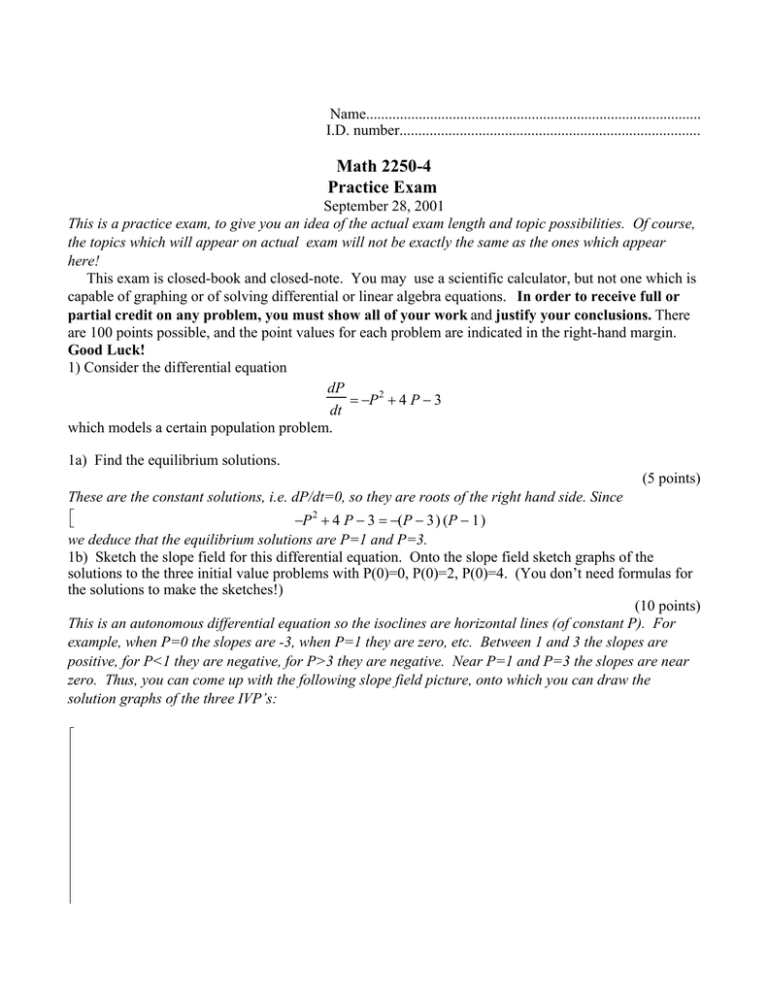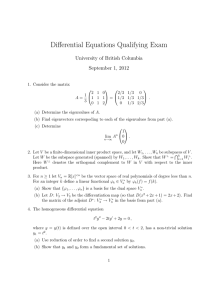Name......................................................................................... I.D. number................................................................................
advertisement

Name......................................................................................... I.D. number................................................................................ Math 2250-4 Practice Exam September 28, 2001 This is a practice exam, to give you an idea of the actual exam length and topic possibilities. Of course, the topics which will appear on actual exam will not be exactly the same as the ones which appear here! This exam is closed-book and closed-note. You may use a scientific calculator, but not one which is capable of graphing or of solving differential or linear algebra equations. In order to receive full or partial credit on any problem, you must show all of your work and justify your conclusions. There are 100 points possible, and the point values for each problem are indicated in the right-hand margin. Good Luck! 1) Consider the differential equation dP 2 = −P + 4 P − 3 dt which models a certain population problem. 1a) Find the equilibrium solutions. (5 points) These are the constant solutions, i.e. dP/dt=0, so they are roots of the right hand side. Since −P 2 + 4 P − 3 = −(P − 3 ) (P − 1 ) we deduce that the equilibrium solutions are P=1 and P=3. 1b) Sketch the slope field for this differential equation. Onto the slope field sketch graphs of the solutions to the three initial value problems with P(0)=0, P(0)=2, P(0)=4. (You don’t need formulas for the solutions to make the sketches!) (10 points) This is an autonomous differential equation so the isoclines are horizontal lines (of constant P). For example, when P=0 the slopes are -3, when P=1 they are zero, etc. Between 1 and 3 the slopes are positive, for P<1 they are negative, for P>3 they are negative. Near P=1 and P=3 the slopes are near zero. Thus, you can come up with the following slope field picture, onto which you can draw the solution graphs of the three IVP’s: 5 4 3 P(t) 2 1 –4 –2 0 –1 2 4 t 1c) Which of the equilibrium solutions are stable? Which are unstable? (5 points) We see that IVP’s with initial values near P=3 converge to P=3, so P=3 is asymptotically stable. Solutions with IV’s near P=1 do not stay near P=1, so P=1 is unstable. 1d) Give a population model which leads to differential equations of this type. Be as precise as you can, so that you can account for the signs of all three terms on the right-hand side of the differential equation. (5 points) An equation of the form dP = −P 2 + 4 P dt would be logistic, so what we have here is logistic, with constant rate harvesting. 1e) Find a explicit solution to the initial value problem for this differential equation, with P(0)=2. Verify that your limiting population agrees with what your sketch predicted in part 1b). (15 points) We separate variables to solve this DE: dP = −dt (P − 3 ) (P − 1 ) we use partial fractions to do the left-side integral: 1 A B + = (P − 3 ) (P − 1 ) P − 3 P − 1 1 = A (P − 1 ) + B (P − 3 ) letting P=1 and P=3 yields 1 = −2 B 1=2A or 1 2 -1 B= 2 so, we multiply our separted DE by 2, and integrate: ln( P − 3 ) − ln( P − 1 ) = −2 t + C P−3 = −2 t + C ln P−1 P−3 ( −2 t ) =Ce P−1 Since P(0)=2 we deduce P−3 ( −2 t ) = −e P−1 A= P − 3 = (1 − P ) e P (e ( −2 t ) ( −2 t ) + 1) = 3 + e P(t ) = 3+e ( −2 t ) ( −2 t ) ( −2 t ) +1 Thus P(t) --> 3 as t--> infinity. 2) Consider a brine tank which holds 15,000 gallons of continuously-mixed liquid. Let x(t) be the amount of salt (in pounds) in the tank at time t. The in-flow and out-flow rates are both 150 gallons/hour, and the concentration of salt flowing in is 1 pound per 10 gallons of water. 2a) Explain how the information above leads to the differential equation dx + .01 x = 15 dt ( 5 points) The rate of change of x(t) is the rate at which salt is flowing in, minus the rate at which it is flowing out. The rate at which it is flowing in is (0.1)*150 pounds/minute, and assuming uniform mixing the output concentration is x/15,000 pounds/gallon, so the rate at which salt is flowing out is 150*x/15,000 = x/100 pounds per minute. Thus dx 1 x = 15 − dt 100 which is equivalent to the given differential equation. 2b) Solve the initial value problem for this differential equation, assuming that at time t=0 there is no salt in the water. e (10 points) This is a linear DE, where "P(t)"=.01, so the integrating factor is exp(.01*t): ( .01 t ) dx + .01 x = 15 e (.01 t ) e dt integrate both sides to obtain e ( .01 t ) x = 1500 e ( .01 t ) x(t ) = 1500 + C e +C ( −.01 t ) Since x(0)=0 we deduce C=-1500, so ( −.01 t ) x(t ) = 1500 − 1500 e 2c) What is the limiting amount of salt as t approaches infinity? (5 points) The limiting amount of salt is 1500 pounds, which we expect since the limiting concentration should be the concentration coming in, which is 0.1 pounds/gallon. 3) Consider the matrix 2 A := 1 0 0 1 1 1 1 1 3a) Compute determinant(A). What does this computation tell you about whether A is singular or nonsingular? (5 points) det(A)=2+0+1-0-2-0=1. Since det(A) is nonzero, the inverse of A exists. 3b) Find the inverse matrix to A, using the row-operation algorithm. Remember to show all work, as always. Hint: The correct inverse matrix has no fractions in it, which you could deduce from your answer to part (4a). (15 points) Augment A with the identity matrix and then compute the rref. Of course, on the exam you must do this by hand and show your work. I’ll have maple do it: 2 0 1 1 0 0 AaugId := 1 1 1 0 1 0 0 1 1 0 0 1 0 1 -1 1 0 0 2 -1 RREF := 0 1 0 -1 1 -2 2 0 0 1 Thus the inverse matrix is 0 -1 1 1 2 -2 -1 -1 2 3c) Recompute the inverse, using the adjoint formula. Show the cofactor matrix as well as the adjoint matrix as intermediate steps, so that I can check your work. (15 points) The matrix of cofactors (equal to (-1)^(i+j) times the minor Mij) is 1 0 -1 2 -2 cof := 1 -1 -1 2 The adjoint is the transpose of the cofactor matrix: 1 -1 0 2 -1 adj := -1 2 1 -2 The inverse is 1/det times the adjoint matrix. Since det=1, the adjoint matrix above IS the inverse matrix. 3d) Use the inverse matrix from (3b) or (3c) to solve the system 0 1 x 1 2 y = 2 1 1 1 1 1 z 2 0 (5 points) The solution to Ax=b is x=(inverse(A))*b: x y z 1 0 = -1 2 1 -2 x y = z (which is easily seen to solve the original system.) -1 -1 2 0 1 1 1 2 2



